- Local Time: 05:27 AM
- Weather: 16 ℃ / 61 ℉
The Wait Is Over – The GRAND EGYPTIAN MUSEUM Is Opening Its Doors! Be among the first to explore Egypt’s greatest treasure.
The Dendera Temple Complex near Qena is one of ancient Egypt’s best-preserved and spiritually significant sites. Spanning 40,000 m², it features the grand Temple of Hathor, chapels, crypts, a sacred lake, and a Coptic church. Originating in the Old Kingdom and expanded during the Ptolemaic and Roman eras, Dendera blends religious, artistic, and astronomical heritage. Notable highlights include the Dendera Zodiac and the enigmatic
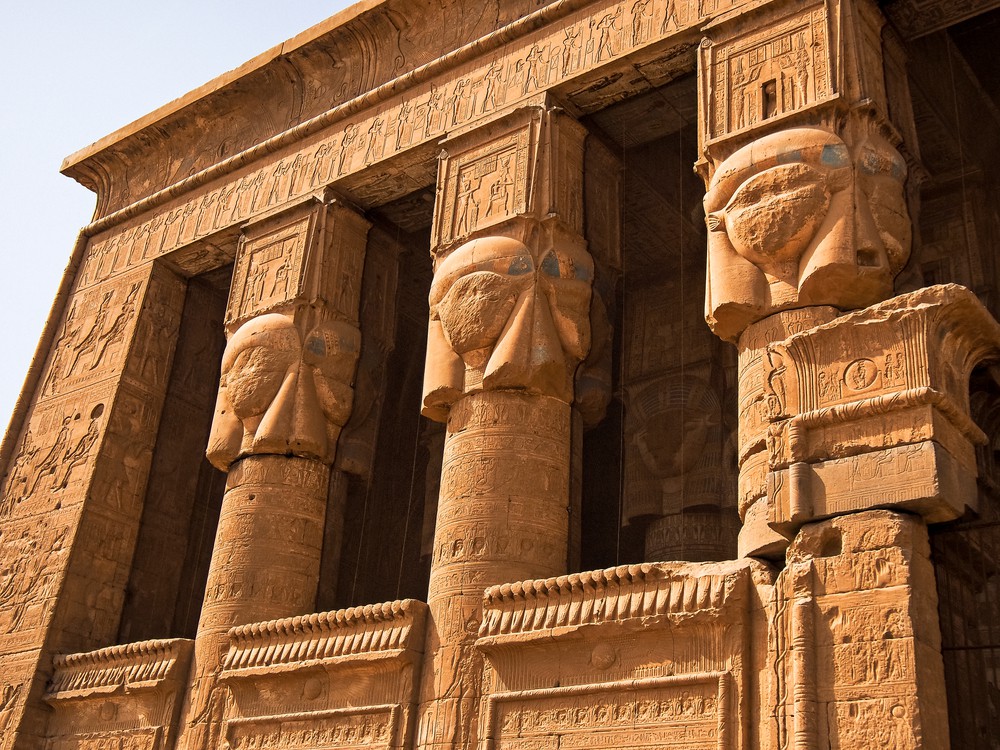
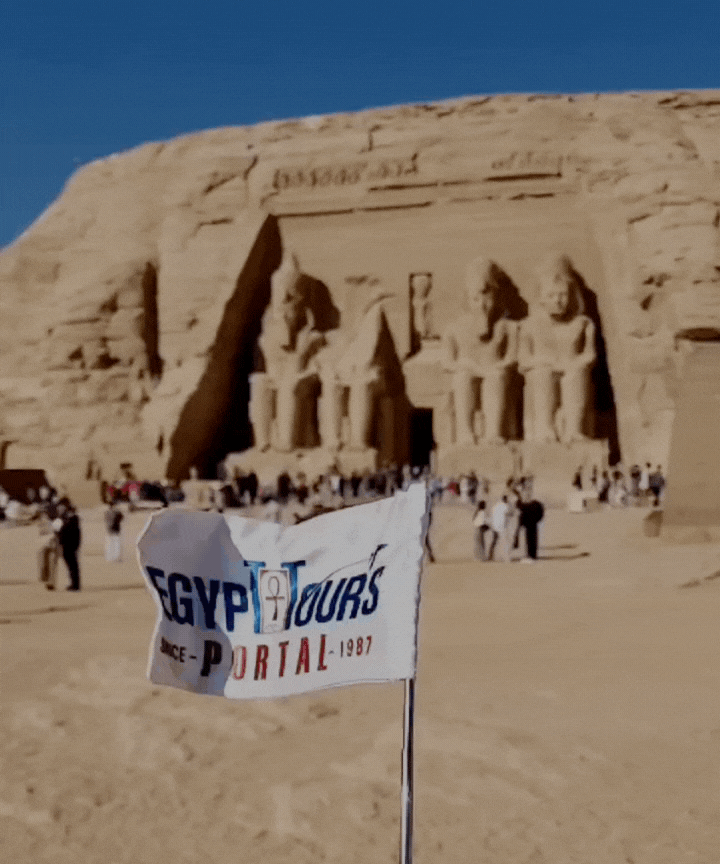
The Dendera Temple Complex is a remarkable and historically rich archaeological gem that sits across 40,000 square meters and is encircled by an ancient mudbrick wall. This site served as a major religious center in ancient Egypt and features the well-preserved Temple of Hathor, the goddess of love, music, fertility, and motherhood. This divine gem is renowned for containing remnants of other ancient Egyptian temples, shrines, and sanctuaries dating as far back as the Old Kingdom (2575–2150 BCE), which makes it one of the most unique masterpieces ever created in existence.
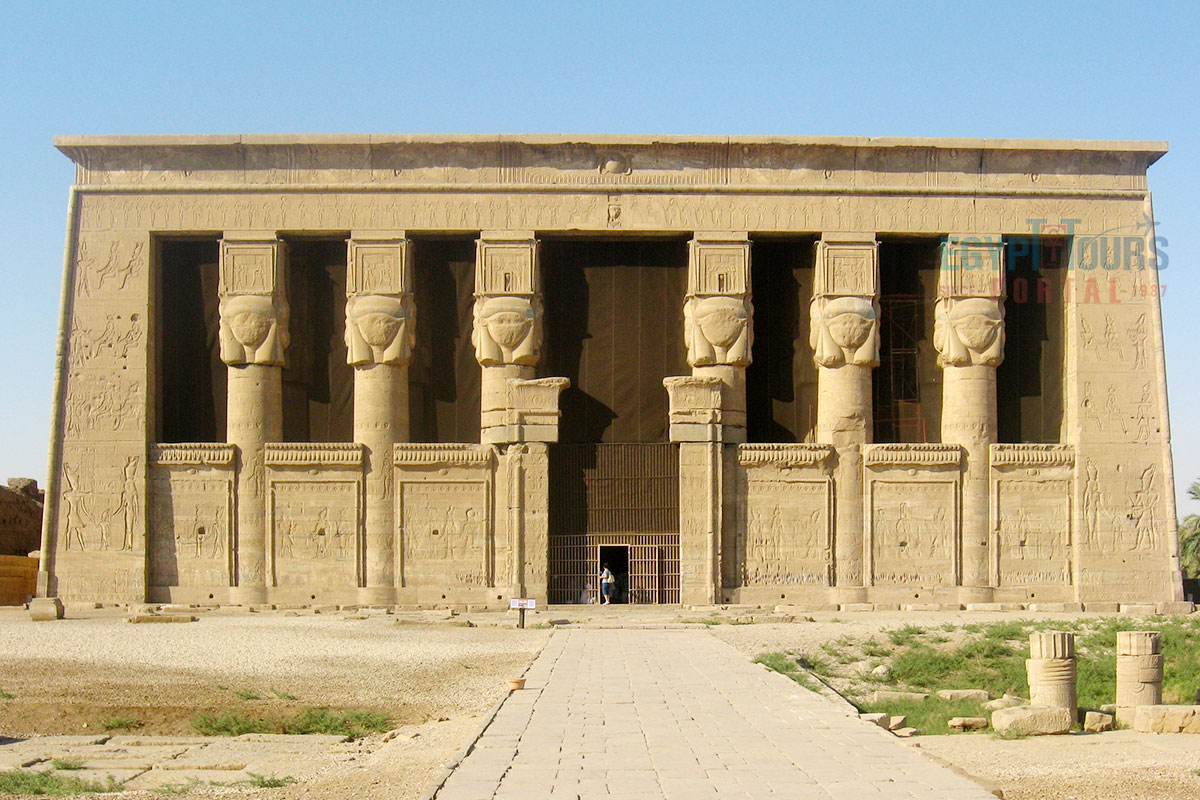
The Dendera Temple Complex is located on the west bank of the Nile river, roughly 2.5 kilometers southeast of Dendera, and near the city of Qena in Upper Egypt. Positioned opposite Luxor, Dendera is easily accessible from this major tourist hub. The temple is nestled amidst the desert landscape but close enough to the river to have thrived as a vital religious and cultural center in ancient Egypt.

The Dendera Temple Complex is one of Egypt’s most significant religious sites. The complex underwent various reconstructions, expansions, and renovations, with structures that reflect the styles, deities, and beliefs of each successive era. The site originally dates back to the Old Kingdom, with evidence pointing to Pharaoh Pepi I of the Sixth Dynasty laying the foundational elements. This early phase established Dendera as a place of worship that would evolve over millennia.
The most visible and celebrated structures today were predominantly completed during the Greco-Roman period, with key contributions by ancient Egyptian rulers from both Greek and Roman backgrounds. Roman Emperor Tiberius, who reigned from 14–37 AD, notably contributed to the Temple of Hathor, the focal point of the complex. His additions, along with those by earlier Ptolemaic pharaohs, reflect a cultural blending, as emperors and pharaohs adopted Egyptian iconography and rituals to honor the goddess Hathor, thereby solidifying their legitimacy among the Egyptian populace.
Beyond the Temple of Hathor, the Dendera complex also houses other religious structures, which provide a fascinating look into the practices of Ancient Egyptian religion. Among these is a small Coptic church, a reminder of Egypt’s Christian period and the adaptations the complex underwent as new religions emerged. Another notable structure is the "Mammisi" or birth house.
This sanctuary, dedicated to the divine birth of ancient Egyptian gods, especially emphasizes the nativity of Isis, the goddess of magic, motherhood, and fertility. The birth house is adorned with carvings that depict the goddess Isis, her son Horus, and the celestial events associated with their divine origins.

The Temple of Hathor is the crown jewel of the Dendera complex, which is an impressive structure that was commissioned in the 1st century BCE by Pharaoh Ptolemy VIII and Queen Cleopatra II. Its architecture is distinguished by an 18-column hypostyle hall featuring richly decorated Hathoric columns, each topped with the visage of Hathor.
The temple walls and ceilings are adorned with intricate carvings and painted scenes, illustrating various rites, rituals, and offerings made to Hathor by Roman emperors. One of the most visually captivating elements is the ceiling, adorned with astronomical motifs, including the figure of the sky goddess Nut bending over the earth, the sun disc, and scenes depicting the sun boat of Hathor and Horus, her consort.
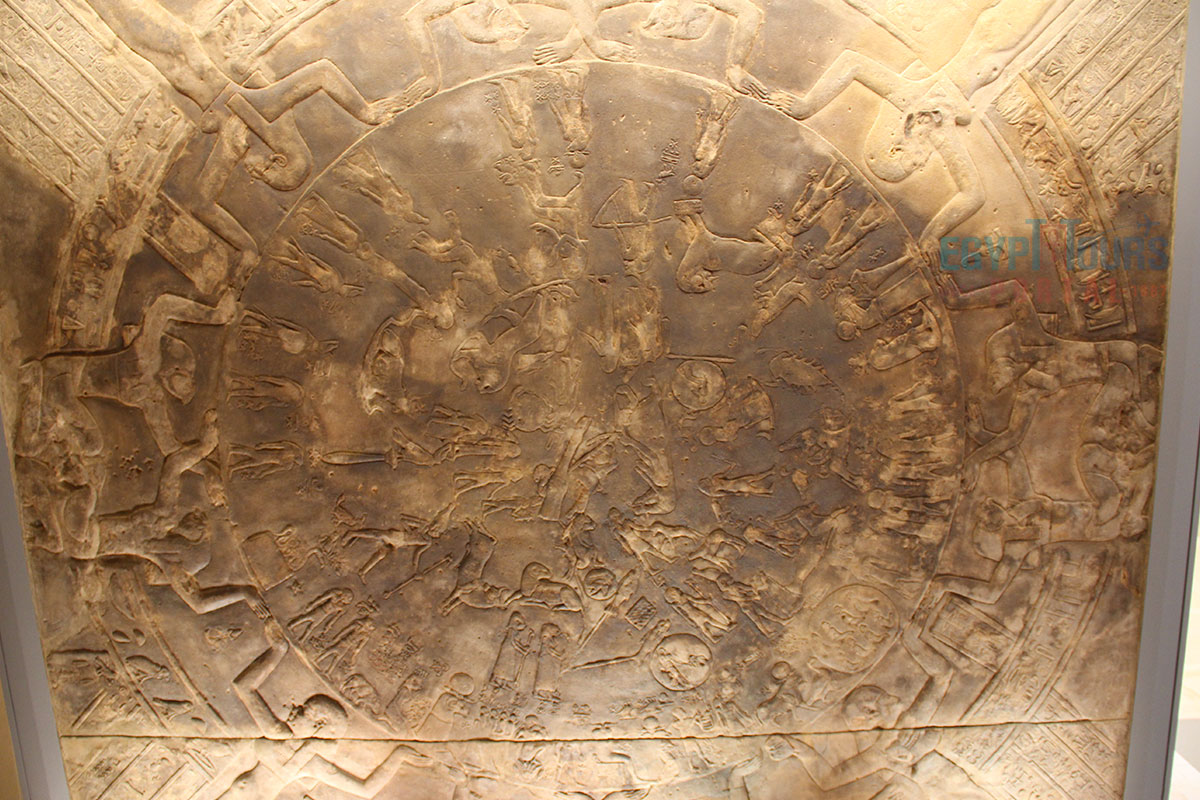
One of the temple’s most famous features is the Dendera Zodiac, a unique circular relief that acts as a powerful map made of 12 constellations in a celestial chart. This astronomical masterpiece, found in the Osiris chapel of the Temple of Hathor, includes representations of constellations familiar today, such as Aries (the ram), Taurus (the bull), and Gemini (the heavenly twins).
Ancient Egyptians likely used this star map to create their calendar and align their rituals with celestial events. However, in 1820, French forces removed the original zodiac and transported it to the Louvre Museum in Paris, where it remains today. The Dendera ceiling now contains a replica to preserve the significance of this sacred feature.
Explore the glorious zodiacs of the ancient Egyptian civilization
Read More
A controversial theory linked to the Dendera Temple Complex centers around a stone relief depicting a Djed pillar and lotus flower with a serpent emerging from it, resembling what some believe to be an ancient lightbulb. This image, often referred to as the "Dendera Light," has led to speculation that the ancient Egyptians possessed knowledge of electricity or lighting devices.
However, mainstream Egyptologists and scholars interpret this imagery as symbolic, representing the fusion of life and ancient Egyptian creation myths involving Hathor, Harsomtus (the form of Horus represented by the snake), and the renewal of divine energy rather than evidence of ancient electrical technology.
Discover the mystery and power of Ancient Egyptian Electricity
Read More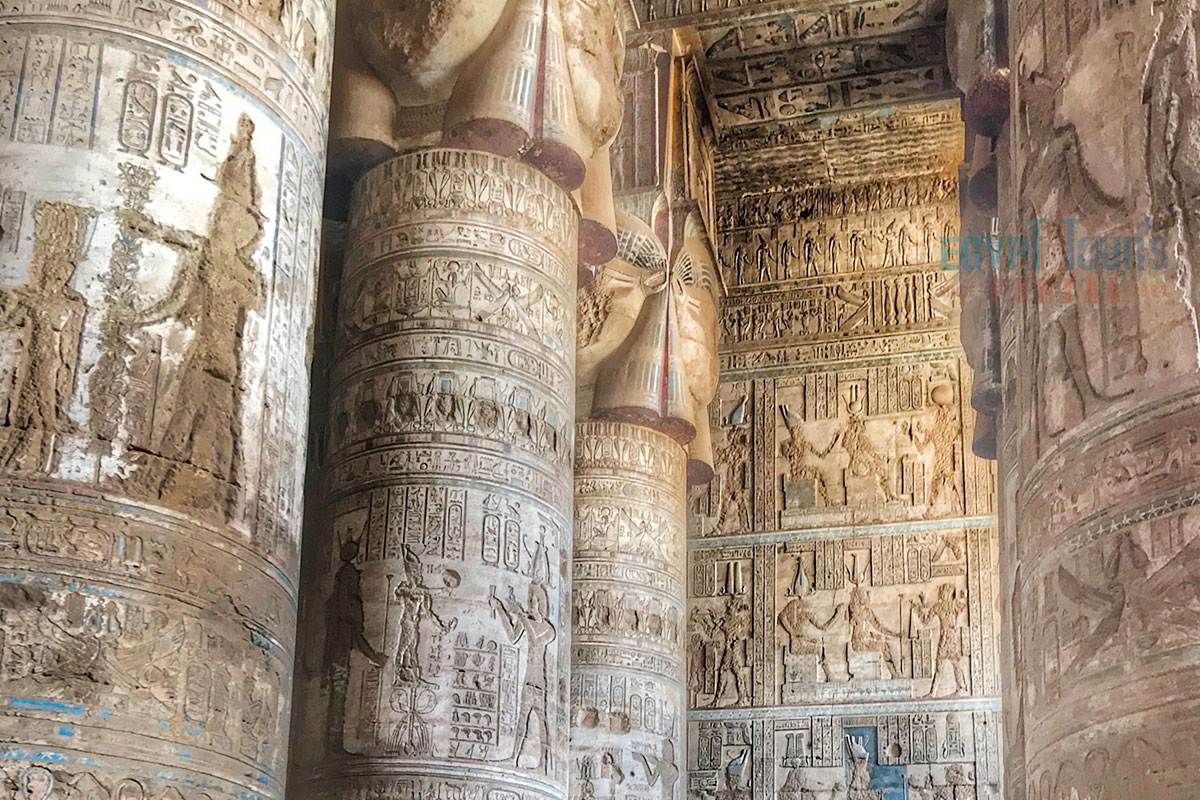
At the heart of the complex is the Temple of Hathor, which is a prime example of Ptolemaic architecture that captures the splendor of ancient Egyptian worship. The main temple includes an imposing hypostyle hall with 24 columns topped by the iconic Hathoric capitals, where Hathor’s face is carved in intricate detail on each column. The interior is richly adorned with scenes of religious rituals, celestial imagery, and offerings, all painted in hues that retain surprising brightness.
Highlights include a chapel dedicated to Osiris, the god of the underworld, which was reserved for significant rites involving death and rebirth. The walls also depict Roman emperors, who, adopting the guise of Egyptian pharaohs, offer homage to Hathor and other gods, showcasing the cultural syncretism that characterized Egypt under Roman rule. Visitors can ascend to the temple roof for a panoramic view of the surrounding desert landscape, an area that was used for rituals and offers insights into the spiritual significance of the rooftop spaces in Egyptian temples.
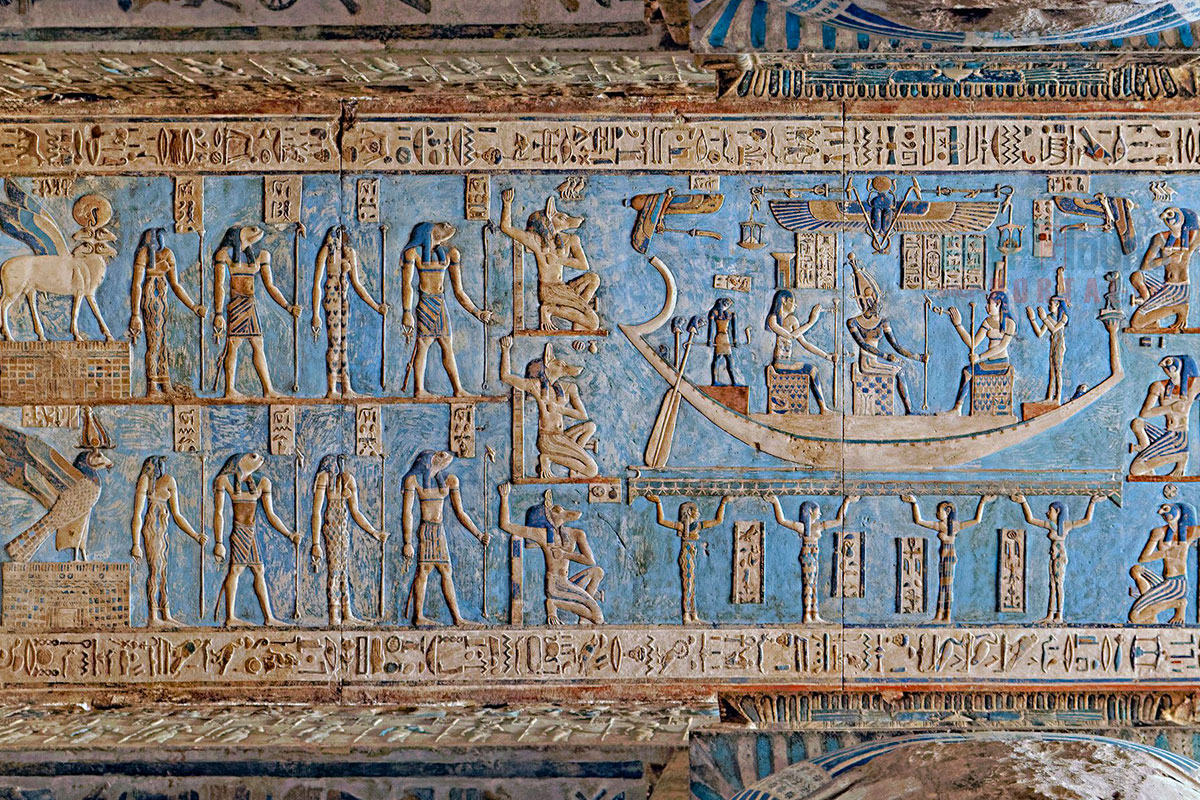
The hieroglyphic inscriptions at Dendera are among the most elaborate and finely executed in Egypt. They provide a glimpse into the ancient Egyptian mythology, cosmology, and religious life of the time. These hieroglyphs record prayers, rituals, and mythological narratives, often accompanied by reliefs that breathe life into Egypt’s rich pantheon of gods and goddesses.
A famous and debated hieroglyph, the “Dendera Light,” depicts a snake emerging from an oval container. This unique imagery has led to speculations of ancient Egyptian technology, as some claim it resembles an electric lightbulb, though mainstream Egyptologists interpret it as a representation of the god Harsomtus, linked to the myth of creation. The crypt inscriptions are particularly unique, with deeper meanings associated with divine energy and hidden knowledge, often believed to convey blessings or protect sacred objects hidden within these chambers.

Beneath the main temple, Dendera’s crypts are a fascinating network of small, concealed chambers thought to store sacred objects and images of deities connected to Hathor. These crypts were often considered holy places, holding powerful objects used in temple ceremonies and protecting the sacred symbols from external forces.
Accessible only by narrow, steep passages, the crypts contain reliefs that depict pharaohs, including Pepi I, in acts of devotion, offering statuettes and other precious items to Hathor and other gods. These hidden spaces are particularly significant as they illustrate the ancient Egyptians' views on secrecy and the sacredness of certain ritual objects, as well as their belief in the concentrated divine energy within these enclosed spaces.

The engravings at Dendera are celebrated for their artistic and symbolic richness, featuring scenes of Roman emperors depicted as Egyptian pharaohs. They are often shown making offerings to the gods Hathor and Horus, signifying a blend of Egyptian and Roman religious practices. These detailed reliefs depict ancient Egyptian festivals, rituals, and mythological events, as well as elaborate astronomical scenes that link human and cosmic cycles.
Many carvings show processional ceremonies and religious observances, emphasizing the depth of devotion and the complex interplay between religion, royalty, and art. The engravings demonstrate the high level of skill and dedication of ancient artisans, while also highlighting the influences of foreign rule on ancient Egyptian art.

Dendera’s architecture showcases a blend of Egyptian and Greco-Roman influences, reflecting the changes in power and cultural exchange over Egypt’s long history. The temple complex features large, monumental walls and well-preserved gateways decorated with vibrant carvings. Its hypostyle halls, colonnades, and multi-layered sanctuaries speak to the architectural advancements of the time.
The temple’s layout, with open-air courtyards leading into progressively more sacred spaces, follows traditional Egyptian temple design, signifying the path from the profane to the divine. The extensive use of stone, the scale of the columns, and the structural integrity of the walls highlight the advanced construction techniques and the grand vision of those who contributed to Dendera’s construction over many centuries.
The hypostyle hall, adorned with vivid astronomical carvings, demonstrates the Egyptians’ knowledge of ancient Egyptian astronomy and their attempts to connect earthly spaces with the cosmos.
Explore the marvelous architecture of the ancient Egyptian civilization
Read More
The Dendera complex includes several other intriguing features, such as the processional staircase that would have been used in rituals, showing wear from countless ceremonies conducted over the centuries. The site contains crypts that held sacred objects, which were considered powerful and imbued with divine energy. Some of these crypts feature carvings of Ptolemaic kings making offerings, underscoring the temple’s continued spiritual importance through successive dynasties.
In 2023, archaeologists made a new discovery at Dendera, which is a limestone sphinx with distinct facial features, thought to represent the Roman Emperor Claudius. The sphinx is adorned with a nemes and cobra-shaped uraeus, which is a testament to the Roman influence in Egypt and reflects how the emperors assimilated ancient Egyptian symbols to assert their rule.

Ongoing restoration efforts, which began in 2005, have aimed to preserve the vivid colors and elaborate decorations that make Dendera a world-renowned historical site. After pauses in the restoration work due to political and social unrest in 2011, efforts resumed in 2017. Conservationists and Egyptologists have worked tirelessly to clean and stabilize the temple’s structure and restore its original colors.
In collaboration with the French Archaeological delegation, Egyptian authorities are also transforming parts of the site into an open-air museum to make it more accessible to the public and deepen understanding of its cultural and historical importance.
The Dendera Temple Complex stands as a breathtaking proof of the genius of ancient Egyptian civilization’s artistry, religious beliefs, and architectural prowess. The site continues to reveal new aspects of history and attracts scholars and travelers alike who are captivated by its beauty and the mysteries it holds about Egypt's past. This temple can't be missed during your Egypt tours or Nile river cruise, so make sure to take advantage of each moment and live your dream adventure across the golden lands of Egypt.
Day Trip from Luxor to Cairo by Plane For South-African Travelers Day trip from Luxo...
Tour Location: Cairo...
Tour to Luxor West Bank For South-African Travelers Tour to Luxor West Bank is like ...
Tour Location: Luxor...
Tour to Edfu and Kom Ombo For South African Travelers Edfu & Kom Ombo tour ...
Tour Location: Edfu/Kom Ombo...
Trip to Dandara and Abydos from Luxor for South African Travelers A Trip to Dandara ...
Tour Location: Dandara/Abydos...
Dendera is celebrated for its well-preserved Temple of Hathor, its vibrant hieroglyphs, and unique elements like the Dendera Zodiac, which links ancient Egyptian cosmology to Greco-Roman astrology. The site is also known for the Dendera Light relief, sparking theories about ancient technology.
Dendera is a must-see for those interested in Egyptian art, history, and mythology. The vibrant colors, preserved engravings, and less-crowded atmosphere offer a unique and immersive experience, distinct from other ancient sites in Egypt.
The "Lady of Dendera" refers to Hathor, the goddess of love, beauty, music, and motherhood, worshipped as the main deity at Dendera. Her temple was a pilgrimage site and cultural hub where her devotees gathered to celebrate and honor her.
The temple we see today was primarily built by Ptolemaic pharaohs, especially Ptolemy XII and Cleopatra VII, and completed by Roman emperors like Tiberius. However, its foundations date back to the Old Kingdom under Pharaoh Pepi I.
The Dendera Zodiac is a star map engraved on the ceiling of the Temple of Hathor, illustrating constellations still recognized today. It symbolizes the Egyptians’ fascination with astronomy and was used to align religious festivals with celestial events.
Dendera is about 60 kilometers (37 miles) north of Luxor, making it an easy day trip by car, approximately a 1.5-hour drive, allowing visitors to explore both the Luxor and Dendera temples in a single day.
The controversy surrounding the Dendera Zodiac stems from its removal by French scholars in 1820, who transported it to France, where it now resides in the Louvre. This removal sparked debates about the ethicality of relocating ancient artifacts and the preservation of cultural heritage.
Dendera's origins trace back to Egypt’s Old Kingdom (2575–2150 BCE), although the primary structure, the Temple of Hathor, dates to the late Ptolemaic period around the 1st century BCE and was completed under Roman rule.
Dendera was known throughout history, but it was rediscovered and explored in detail by early European archaeologists in the 19th century known as Giovanni Battista Belzoni. Its full exploration continues to reveal new findings even today.
The Egyptians were keen astronomers and developed a zodiac that divided the heavens into 12 constellations, much like the Greek zodiac. The Dendera Zodiac is an artifact of this Egyptian system, highlighting how cosmology was integrated into their religious and daily lives.
The entire country of Egypt deserve to be explored with its every heavenly detail but there are places that must be seen before any other such as the breathtaking Hurghada's red sea, The wonders of Cairo the pyramids of Giza, the great sphinx, the Egyptian Museum, Khan El Khalili Bazaar, the wonders of Luxor like Valley of the Kings, Karnak & Hatshepsut temple and the wonders of Aswan such as Abu Simbel temples, Philea temple, Unfinished obelisk and The Wonders of Alexandria like Qaitbat Citadel, Pompey's Pillar and Alexandria Library. Read more about the best places to visit in Egypt.
If you want to apply for a Visa On Arrival that lasts for 30 days then you should be one of the eligible countries, have a valid passport with at least 6 months remaining and pay 25$ USD in cash, as for the E-Visa for 30 day you should have a valid passport for at least 8 months, complete the online application, pay the e-visa fee then print the e-visa to later be presented to the airport border guard. You could also be one of the lucky ones who can obtain a free visa for 90 days. Read more about Egypt travel visa.
Egypt has a variety of delicious cuisines but we recommend “Ful & Ta’meya (Fava Beans and Falafel)”, Mulukhiya, “Koshary”, a traditional Egyptian pasta dish, and Kebab & Kofta, the Egyptian traditional meat dish.
The best time to travel to Egypt is during the winter from September to April as the climate becomes a little tropical accompanied by a magical atmosphere of warm weather with a winter breeze. You will be notified in the week of your trip if the Climate is unsafe and if any changes have been made.
You should pack everything you could ever need in a small bag so you could move easily between your destinations.
We have been creating the finest vacations for more than 20 years around the most majestic destinations in Egypt. Our staff consists of the best operators, guides and drivers who dedicate all of their time & effort to make you have the perfect vacation. All of our tours are customized by Travel, Financial & Time consultants to fit your every possible need during your vacation. It doesn't go without saying that your safety and comfort are our main priority and all of our resources will be directed to provide the finest atmosphere until you return home.
You will feel safe in Egypt as the current atmosphere of the country is quite peaceful after the government took powerful measures like restructuring the entire tourist police to include all the important and tourist attractions in Egypt. Read more about is it safe to travel to Egypt.
Wear whatever feels right and comfortable. It is advised to wear something light and comfortable footwear like a closed-toe shoe to sustain the terrain of Egypt. Put on sun block during your time in Egypt in the summer to protect yourself from the sun.
The best activity is by far boarding a Nile Cruise between Luxor and Aswan or Vise Versa. Witness the beauty of Egypt from a hot balloon or a plane and try all the delicious Egyptian cuisines and drinks plus shopping in old Cairo. Explore the allure and wonders of the red sea in the magical city resorts of Egypt like Hurghada and many more by diving and snorkeling in the marine life or Hurghada. Behold the mesmerizing western desert by a safari trip under the heavenly Egyptian skies.
There are a lot of public holidays in Egypt too many to count either religious or nation, the most important festivals are the holy month of Ramadan which ends with Eid Al Fitr, Christmas and new years eve. Read more about festivals & publich holidays in Egypt.
Egypt is considered to be one of the most liberal Islamic countries but it has become a little bit conservative in the last couple of decades so it is advised to avoid showing your chest, shoulders or legs below the knees.
Arabic is the official language and Most Egyptians, who live in the cities, speak or understand English or at least some English words or phrases. Fewer Egyptians can speak French, Italian, Spanish, and German. Professional tour guides, who work in the tourism sector, are equipped to handle visitors who cannot speak Arabic and they will speak enough English and other languages to fulfill the needs of all our clients.
The fastest way is a car, of course, a taxi. If you are in Cairo ride a white taxi to move faster or you could board the fastest way of transportation in Egypt metro if the roads are in rush hour.
The temperature in Egypt ranges from 37c to 14 c. Summer in Egypt is somehow hot but sometimes it becomes cold at night and winter is cool and mild. The average of low temperatures vary from 9.5 °C in the wintertime to 23 °C in the summertime and the average high temperatures vary from 17 °C in the wintertime to 32 °C in the summertime. The temperature is moderate all along the coasts.
It is the home of everything a traveler might be looking for from amazing historical sites dating to more than 4000 years to enchanting city resorts & beaches. You will live the vacation you deserve as Egypt has everything you could possibly imagine.









